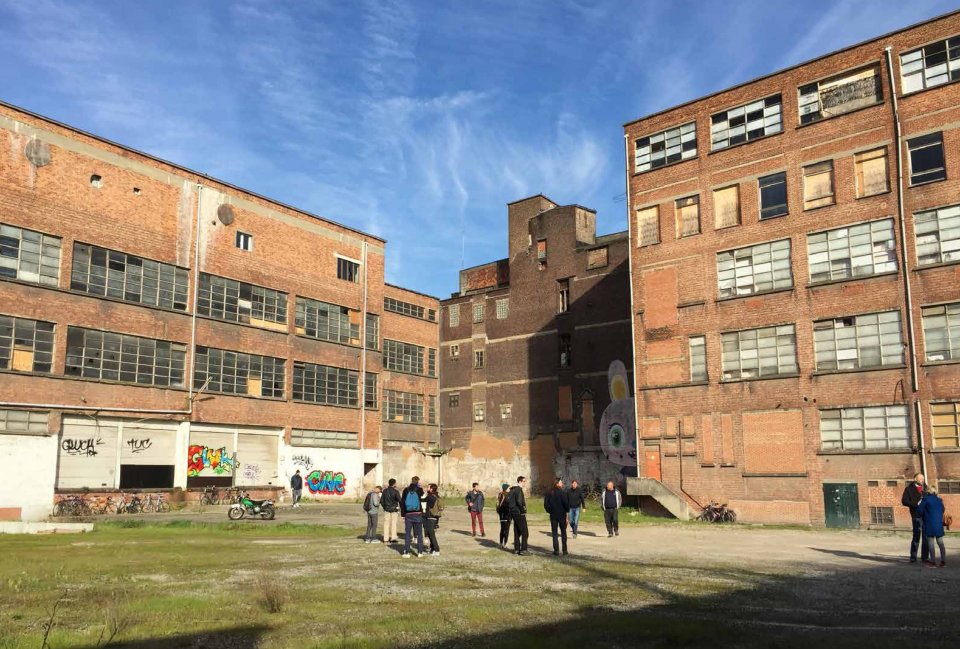
Converting underused real estate assets into local economic hubs.
The Project
The Goal
At a building scale, the goal of the project is to create an "ecology of temporary uses" whereby there is co-dependence between actors. On a larger-scale, the main goals are to reach out to existing local residents and look forward into the future of the site.
Local Task Force
OSMOS facilitated the process which was supported by a wide number of local organisations. Even though the most active stakeholder is the building owner (the regional developer citydev.brussels), the local community plays a significant role too. In addition, the initial co-development process involved the "pioneer group": Entrakt (the building administrator), Congres (a cultural organisation), Foreseen (a dance company), Miauw (an events organisation), SeventySeven (a theatre company) and the SuperLab (a fabrication space).
The Process
The Studio Cureghem is a large industrial site (~25,000 sqm), located 800 m from the largest train station in Brussels. The neighbourhood will be undergoing large changes over the coming decade and therefore this building will remain empty during the transition process. As a result, the project involves co-developing temporary uses at the scale of the building.
Existing Dynamics
Many relevant temporary use projects, both in Belgium and beyond, were used as case studies. In the Netherlands, there are projects such as Pakhuis De Zwijger (Amsterdam), De Cuivel (Amsterdam), Paradiso (Rotterdam), the Schieblock (Rotterdam), the Phoenix Food Hall (Rotterdam) and others, that have successful temporary attractions which drew a crowd. There are also co-working projects such as Das Pakhuis in Vienna and garden spaces Frau Gerold in Zurich. However, the approach depends entirely on the local resources and the participants which meant these case studies were used mainly for inspiration rather than to follow similar steps. On the other hand, even though there is any direct connection to the political level, the site not only addresses the regional circular economy plan by making careful use of materials, but also possible future land use mixes for the new development in Biestebroek - an issue that has been of concern to the regional authorities for some time.
Obstacles
The project has faced some challenges related to the agency and spontaneity of the users. However, this is a necessary part of the organic development of the site and its adaptation to the changing circumstances. whoIn addition, the site has also been controlled by the owner who is concerned not to impact surrounding residents or give the site a poor image.
Resources
The site is being developed with the resources available to it and therefore is relatively practical in terms of ambitions and resourceful in terms of using those at direct disposal.
In practice, despite the small financial resources or public support, the great technical knowledge provided by a number of partners has meant a large saving on investments into security, services, electricity and so forth. In addition, the free use of the building for an undermined period it is also a significant cost-saving.
Strokes of Luck
The free use of the building over 3-5 years has meant that expectations are low and there is a large range of opportunities.
The Achievements
Short-term Results
Although the project has not produced a measurable impact yet, its main outcome is the functional, innovative and vibrant building that connects to the neighbourhood beyond.
Long-term Benefits
In the long-term, the site can have a positive influence on the conditions within the established neighbourhood (Cureghem) and the future development neighbourhood (Biestebroek). In this regard, it is expected that the project will result in softening the edge between the existing neighbourhood and the future development by fostering interesting land-use mixes (for instance, how small industry can be mixed with housing) and by creating a unique site that enables the encounter between users/occupants. In addition, the project will enhance social sustainability in terms of bringing together actors and local interest groups; Technical/environmental sustainability in terms of re-using an old building and making an efficient use of the resources generated on site (water and electricity); Economic sustainability in terms of ensuring the building functions with little external funding.
Key lesson learned - Adrian explains
"Adaptive development require a number of key enthusiastic actors who share a common vision but bring a distinct and compatible skill sets to the project. This allows for flexibility and chance encounters for dialogue, in order not to create friction between competing or similar participants."
Adrian Hill, Osmos
